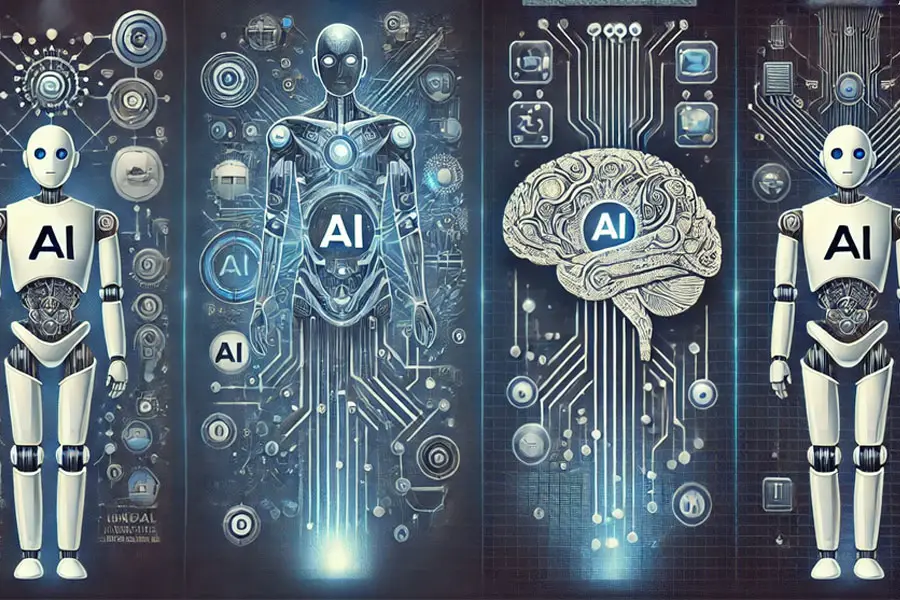Artificial Intelligence, or AI, might sound complicated, but it’s just a fancy way of saying “smart machines.” These machines can do things that usually need human smarts, like recognizing faces in photos or even driving cars. But did you know there are different types of AI? Let’s break them down to make it easy to understand!
What is AI?
AI is like a robot brain that helps machines learn and do tasks on their own. Some types of AI can only do one job, like guessing what movie you’ll like. Other types of AI, which don’t exist yet, might one day be as smart as a human and do any task we can.
Types of AI Technology
AI comes in different types based on how “smart” they are and what they can do. There are four main levels:
- Narrow AI (also called Weak AI)
- Artificial General Intelligence (AGI)
- Theory of Mind AI
- Self-Aware AI
Let’s dive into what each of these means.
Narrow AI: The Common Type of AI Today
Narrow AI, also called Weak AI, is the kind of AI we use the most. It can do one specific job really well but can’t do anything else. Think of it like a calculator. It’s amazing at math but won’t help you with spelling!
Examples of Narrow AI:
- Voice Assistants like Siri or Alexa, which answer questions and set reminders.
- Recommendation Systems on YouTube or Netflix that suggest videos or shows you might like.
- Image Recognition in social media that can tag people in photos.
What is Artificial General Intelligence (AGI)?
Artificial General Intelligence, or AGI, is the next big goal for scientists. AGI would be an AI that’s as smart and flexible as a human. It could learn, reason, and solve problems in many different areas.
Imagine a robot that could help with homework, play games, and even give advice! But right now, AGI is just an idea and hasn’t been created yet.
Levels of AI
AI can also be divided into levels based on how “aware” it is. There are four main levels:
- Reactive Machines
- This type of AI only reacts to what’s happening right now. It doesn’t remember anything.
- Example: IBM’s Deep Blue, a chess computer that could play chess but didn’t remember past games.
- Limited Memory AI
- This AI can remember past data for a little while. It’s used in self-driving cars to help them remember things like speed limits or nearby cars.
- Theory of Mind AI
- This AI would be able to understand emotions and thoughts, just like a person. It’s still a work in progress!
- Self-Aware AI
- This would be the smartest AI, where machines understand themselves and the world around them. Right now, this is science fiction.
Machine Learning AI and Deep Learning AI
Machine learning (ML) and deep learning (DL) are two important tools for teaching AI. They help AI to learn by looking at data, such as photos, videos, or text. Here’s how they work:
- Machine Learning: Teaches AI to learn and make decisions based on patterns in data.
- Deep Learning: A type of ML that uses special “neural networks” to analyze complex patterns, like identifying faces or playing games.
These tools help create many of the AI applications we see today!
Comparing Narrow AI vs. General AI
- Narrow AI: Good at doing one job, like answering questions or finding the fastest route on maps.
- General AI (AGI): Could do any task that humans can do, from learning new languages to solving hard problems. We don’t have this yet.
AI Examples: Weak AI vs. Strong AI
- Weak AI: Examples include voice assistants, chatbots, and recommendation systems. These AIs are helpful for specific tasks.
- Strong AI: This would be AI with human-like intelligence, capable of creative thinking and problem-solving.
Real-World AI Applications
AI is already in many parts of our world! Here are some examples:
- Self-Driving Cars: Use limited memory AI to remember traffic rules and nearby vehicles.
- Healthcare: AI can help doctors diagnose diseases or suggest treatments.
- Retail: AI helps stores suggest products based on what you like.
The Future of AI: Where Are We Headed?
In the future, scientists hope to create smarter AI, maybe even AGI. But there are challenges, like making sure AI is safe, ethical, and doesn’t take away jobs.
Cognitive Computing in AI
Cognitive computing is a type of AI that tries to think like a human. It’s used in areas like finance and law to help professionals analyze large amounts of data quickly.
Why AI Is Exciting
AI is helping us do things faster and more efficiently. From checking the weather to exploring space, AI has amazing potential. It will keep evolving, and maybe someday, we’ll have AGI that can think and learn just like us!
FAQs
What’s the future of AI?
Scientists hope to create even smarter AI in the future, possibly even Artificial General Intelligence!
What is Narrow AI?
Narrow AI is a type of AI that can do only one specific job, like answering questions or suggesting movies.
What’s the difference between Narrow AI and General AI?
Narrow AI is limited to one task, while General AI could learn and do many things, just like a human.
What is Machine Learning?
Machine Learning helps AI learn by using data, so it can recognize patterns and make decisions.
What are AI Levels?
AI levels describe how “smart” AI is, from simple reactive machines to self-aware AI.

